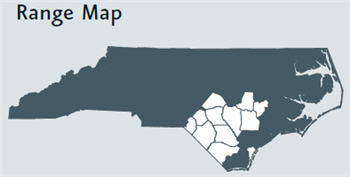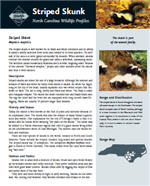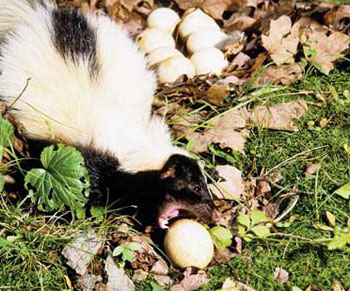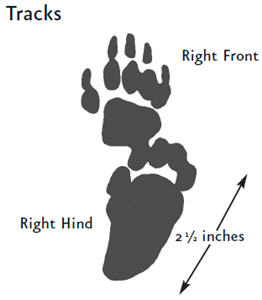Striped Skunk
Mephitis mephitis
by Elizabeth T.I. James
Updated by Colleen Olfenbuttel
North Carolina Wildlife Resources Commission, 2009.
Classification
 Class: Mammalia
Class: Mammalia
Order: Carnivora
Average Size
Length: 1.7-2.6 ft.
Height: 6-9 in.
Weight: males 6-14 lbs., females 4-10 lbs.
Food
Insects, worms, small rodents, bird eggs, reptiles, fruits, acorns, seeds.
Breeding
Promiscuous; males will mate with several females. Breed between mid-February and mid-April. Males remain solitary except when mating. Gestation period is 66 to 75 days.
Young
Called kits. Litter size is 5 to 9. Kits born May to early June. Kits nurse for about 7 to 8 weeks and open their eyes at 22 days. Kits follow their mother on hunting trips at 2 months old and leave the family in the fall. Musk is present at birth and can be emitted at 8 days old. Sexually mature between 1 and 2 years.
Life Expectancy
1 to 6 years in the wild. Up to 10 years in captivity.
Range and Distribution
The striped skunk is found throughout the lower 48 states except in the Southwest. The striped skunk occupies most of North Carolina, although it is most common in the Mountain and Piedmont regions. It is uncommon in most of the Coastal Plain, where it did not occur historically; it is rare to absent in certain Coastal Plain counties.
General Information
The striped skunk is well known for its black and white coloration and its ability to spray a smelly secretion from scent sacs located in its hind quarters. On each side of the anus is a scent gland surrounded by muscles. When alarmed, skunks contract the muscles around the gland and spray a yellowish, nauseating musk. The secretion causes momentary blindness and a terrible, lingering smell. Because of this natural “chemical weapon,” people and other animals avoid the skunk and treat it with caution.
 Description
Description
Striped skunks are about the size of a large housecat. Although the amount and location of black and white fur varies from skunk to skunk, the white fur, beginning on the top of the head, usually separates into two white stripes that run down its back. The tail is long, bushy and black and white. The head is small and triangular-shaped. The skunk has small rounded ears and beady black eyes. The legs are short and the front feet are equipped with long curved claws for digging. Males are usually 10 percent larger than females.
History and Status
Today, the skunk is best known as the butt of jokes and cartoons because of its unpleasant odor. The skunk was also the subject of many Indian superstitions and myths. One explanation for the city of Chicago’s name is that it is named after an Indian word meaning “the place-of-the-skunk.” The name may be related to a Native American legend that told of a giant skunk being killed
on the southwestern shore of Lake Michigan. The natives used the skunk for food and medicine.
There are four species of skunk in the world, located in North and South America. These include the striped, hooded, hog-nosed and spotted skunks. The striped skunk has 13 subspecies. The subspecies Mephitis mephitis elongate is found in North Carolina. This name comes from the Latin word meaning “bad odor.”
Habitat and Habits
Skunks live in areas with a mixture of woods, brush and open fields broken up by wooded ravines and rocky outcrops. They prefer timbered areas and pastures with good water sources. Skunks create dens by digging into slopes of hills and spend most of the day there.
They hunt and move mostly at night or early morning. Skunks do not hibernate, but, during cold weather, they become dormant and remain in the den most of the winter. During this time their body temperature remains near normal. Several skunks may share the same winter den.
The skunk is an omnivore, with about 80 percent of its diet consisting of insects, worms, small rodents, bird eggs and reptiles. It also eats berries, acorns and other vegetable matter.
Skunks are adept at digging and swimming. They primarily use their nose and ears to forage for food, due to poor eyesight. Skunks frequently leave evidence of their feeding: small, cone-shaped holes in the soil, where they’ve dug for grubs.
On average, skunks live about three years in the wild. Disease and predation usually cause their deaths.
People Interactions
Because skunks move mostly at night, many people never see them unless they are raiding a trash can or get hit by a car. If a person frightens a striped skunk, the skunk first faces the person, straightens its legs, arches its back, puts its tail straight up and bristles the tail hair to give the appearance that it is bigger than it is. It also clicks its teeth and stamps the ground. If the person or animal continues to advance, the skunk bends its body sideways in the form of a “U” so that the hindquarters face the person, then it squirts the musk. Ammonia or tomato juice help remove the odor, if you are sprayed. Carbolic soap and water is best for washing the skin.
Although skunks are seldom trapped for their fur in North Carolina, they are trapped in the northern portions of their range where their fur is finer and the black color more intense. Skunks are affected by people in other ways, through habitat destruction, car accidents and poisoning. Since skunks will eat bird eggs, they are known predators of domestic chicken eggs, as well as turkey and waterfowl eggs. Although illegal, skunks are often poisoned in the mistaken belief that all skunks have rabies. While skunks are one of the main carriers of rabies in North America, the chances of encountering a rabid skunk are very low.
NCWRC Interaction: How You Can Help
Skunks, like several other wild animals, can thrive in suburban and urban areas. To avoid problems with skunks, follow some basic rules:
-
Secure your garbage. Skunks will raid open trash materials and compost piles. Secure your garbage in tough plastic containers with tight-fitting lids and keep inside when possible. Take out trash the morning of pick up. Keep compost piles in containers designed to contain but vent the material.
-
Feed pets indoors. Outdoor feeding attracts skunks and other types of wild animals. Close off crawl spaces under porches and sheds. Skunks will use such areas for resting and raising young. Close shed and garage doors at night, and use chicken wire to keep skunks from digging under porches.
-
Protect your pet from being sprayed. Always turn on a flood light and check your yard for skunks before letting your dog out at night
-
Keep bird feeder areas clean. Use feeders designed to keep seed off the ground. Remove feeders if skunks are regularly seen around your yard.
-
Educate your neighbors. Pass this information along.
References:
The Encyclopedia of North American Wildlife (Bison Books, 1983).
Grzimek’s Encyclopedia of Mammals, Volume 3 (McGraw-Hill Publishing Co., 1990).
Webster, Wm. David, James F. Parnell, and Walter C. Biggs. Mammals of the Carolinas, Virginia, and Maryland (University of North Carolina Press, 1985).
Credits:
Produced by the Division of Conservation Education, North Carolina Wildlife Resources Commission. Cay Cross–Editor.
Illustrated by J.T. Newman. Photos by Steve Maslowski.

1 January 2009 | James, Elizabeth T. I. ; Olfenbuttel, Colleen


